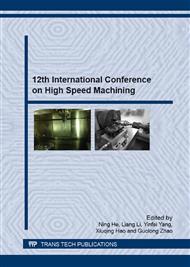p.3
p.13
p.20
p.29
p.36
p.43
p.48
p.56
Application of Different Cooling Strategies in Drilling of Metal Matrix Composite (MMC)
Abstract:
Conventional cutting fluids are known for being expensive, polluting and a non-sustainable part of modern manufacturing processes. Global industrial trends are leaning towards environmental and health friendly technologies. CO2 cooling is an innovative and sustainable method, capable of replacing conventional oil-based cutting fluids under various conditions. The current study intends to cover the indexable insert drilling of aluminium-silicon carbide (Al-SiC) metal matrix composite (MMC) using different diamond coated carbide inserts. Al-SiC composite containing 20% wt. of SiC was used as workpiece material under different cooling strategies. Response Surface Methodology (RSM) and SEM analysis were incorporated to evaluate the tool performance and to understand the wear development in drilling of MMC. Performance tests were carried out at various cutting data and cooling strategies (external CO2, external emulsion, internal CO2 and internal emulsion) in order to study the output in terms of tool life, surface finish and diameter difference of the holes. The results revealed an advantage in the favour of CO2 cooling concerning tool life, precision and surface finish. Drilling with internal supply of CO2 significantly improves the tool life. The internal supply of CO2 generated the best precision and surface finish compared to the other cooling strategies. The test results clearly indicate that the tool failure for internal CO2 is governed by the flaking of the diamond coating in contrast to a combination of flank wear and flaking for emulsion. The results from the external cooling strategy show that there is no significant difference between emulsion and CO2 while the internal cooling strategy shows that CO2 provides the best results. Since the shape and the surface of the hole are generated by the cutting edge of the periphery insert, the wear development on the periphery insert is the main factor which governs the tool life, surface finish and the diameter difference. This can be explained by the internal CO2 strategy that protects the periphery insert.
Info:
Periodical:
Pages:
3-12
Citation:
Online since:
January 2016
Authors:
Keywords:
Price:
Сopyright:
© 2016 Trans Tech Publications Ltd. All Rights Reserved
Share:
Citation:


